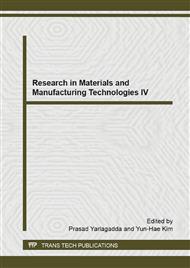p.446
p.450
p.454
p.460
p.465
p.471
p.475
p.481
p.492
Moldflow-Based Optimization Design of Gating System in Injection Mold for Automobile Bumper
Abstract:
The gating system of an injection mold for car bumper was studied. A design optimization scheme is proposed to optimize both the number and locations of the gates by analyzing the filling process, in order to reduce the part war page and weld line, numerical simulation of injection mold filling process is combined with the design optimization method to find the optimum number of gates and their locations to achieve balanced f low and less weld lines while satisfying the limit of injection pressure. Moldflow software was applied to make analysis and comparison of various gating system in terms of their filling time, injection pressure and clamp force, weld line and distribution of air traps, and an optimized gating system was obtained. The result shows that this method can effectively reduce costs, shorten development cycle and improve the efficiency of molding design.
Info:
Periodical:
Pages:
465-470
Citation:
Online since:
December 2014
Authors:
Keywords:
Price:
Сopyright:
© 2015 Trans Tech Publications Ltd. All Rights Reserved
Share:
Citation:


